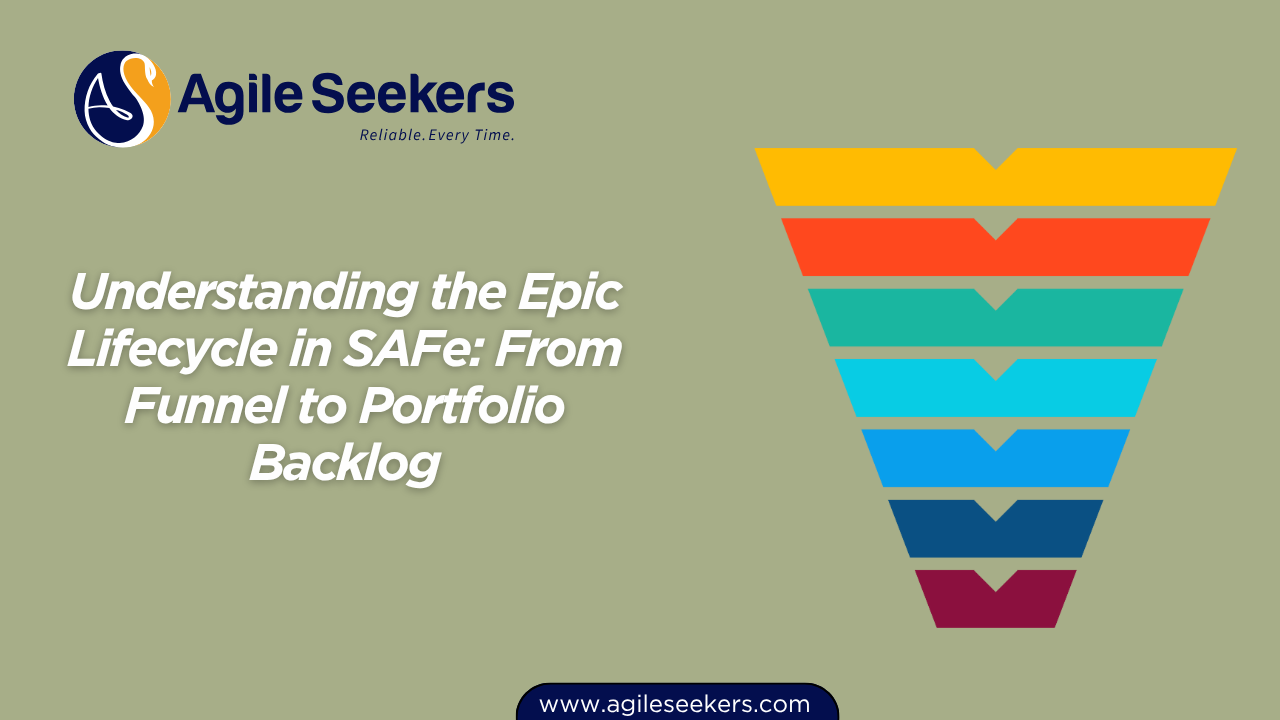Understanding the Epic Lifecycle in SAFe: From Funnel to Portfolio Backlog

In a SAFe® (Scaled Agile Framework) implementation, managing large-scale initiatives requires more than just tracking tasks. Epics play a central role in aligning strategy with execution. These are the container-level initiatives that deliver significant value and require definition, analysis, and approval before they are implemented.
This blog explores the complete lifecycle of an Epic in SAFe—from its entry in the Funnel to its movement into the Portfolio Backlog—while breaking down key decisions, governance gates, and roles involved.
What Is an Epic in SAFe?
An Epic in SAFe represents a significant business or technical initiative that impacts multiple Agile Release Trains (ARTs) or Value Streams. It's large enough that it cannot be completed in a single PI (Program Increment) and must be split into smaller deliverables like Capabilities or Features.
SAFe categorizes epics into:
- Business Epics – customer-facing or internal initiatives that deliver direct business value.
- Enabler Epics – architecture, infrastructure, compliance, or exploration efforts that support future business capabilities.
Read more on epics in SAFe Framework.
The Epic Lifecycle: Step-by-Step Breakdown
The Epic lifecycle in SAFe is designed to ensure strategic alignment and economic decision-making. The flow spans from initial ideation to prioritization in the portfolio backlog.
1. Epic Funnel: Capturing Big Ideas
Every Epic begins its journey in the Funnel, a holding area for all new epic ideas. This funnel isn’t a backlog—it’s more like an idea board. Anyone in the organization, from business leaders to architects, can propose an Epic.
At this stage:
- Epics are high-level and loosely defined.
- They have not been approved for implementation.
- Lean Portfolio Management (LPM) reviews them periodically.
To manage this stage effectively, trained Release Train Engineers and Product Managers help filter ideas that align with the portfolio vision.
📌 SAFe Release Train Engineer Certification Training is ideal if you're looking to lead such initiatives.
2. Epic Hypothesis Statement: Shaping the Idea
SAFe uses the Epic Hypothesis Statement—a lightweight business case that defines:
- Target outcome
- Business benefit
- Leading indicators
- Non-negotiable constraints
3. Lean Business Case: Analysis for Approval
Once an Epic shows potential, it undergoes further analysis. This step involves collaboration between Enterprise Architects, Epic Owners, and Product Managers.
The Lean Business Case includes:
- Strategic fit
- Estimated cost of delay (CoD)
- WSJF score
- MVP definition
- Funding guardrails
🎯 Explore the Leading SAFe Agilist Certification Training to evaluate business cases and drive alignment across teams.
4. Portfolio Kanban: Managing Flow
Once analysis is complete, the Epic enters the Portfolio Kanban. This visual system tracks Epics through:
- Funnel
- Reviewing
- Analyzing
- Portfolio Backlog
- Implementing
- Done
5. MVP Implementation and Validation
Only the Minimum Viable Product (MVP) gets funding initially. This lets teams test feasibility and gather early feedback before making bigger investments.
🎯 Certified SAFe Product Owner/Product Manager (POPM) professionals help shape the MVP into actionable features.
6. Moving to Portfolio Backlog: Prioritizing Value
Validated epics enter the Portfolio Backlog, where they’re prioritized using WSJF and reviewed for strategic alignment and readiness.
📌 Deepen your ability to manage dependencies with the SAFe Advanced Scrum Master Certification.
Key Roles in the Epic Lifecycle
| Role | Responsibility |
|---|---|
| Epic Owner | Leads epic through lifecycle, coordinates across ARTs |
| Lean Portfolio Management | Approves epics, allocates budget, enforces guardrails |
| Enterprise Architect | Supports enabler epics and architecture runway |
| Product Owner / Product Manager | Breaks epics into Features and Stories |
| Scrum Master / RTE | Ensures flow and execution across teams |
To effectively facilitate flow, consider the SAFe Scrum Master Certification.
Tools That Support the Epic Lifecycle
- Portfolio Canvas – maps strategy to value streams
- WSJF – economic prioritization
- Epic Hypothesis Statement – lean business framing
- Portfolio Kanban – visual management of flow
Tips for Success
- Limit WIP and only progress validated Epics
- Use MVP feedback for real-world validation
- Foster collaboration across ARTs and stakeholders
- Educate teams in Lean-Agile mindset
Training in foundational SAFe roles such as SAFe Scrum Master and Leading SAFe helps build alignment and delivery excellence.
Conclusion
The Epic lifecycle in SAFe ensures strategic alignment, lean funding, and fast feedback. From ideation in the Funnel to validated Epics in the Portfolio Backlog, this system streamlines large initiatives without compromising agility.
To build confidence in driving enterprise initiatives at scale, explore AgileSeekers’ programs in Leading SAFe, POPM, and SAFe Scrum Master.




















